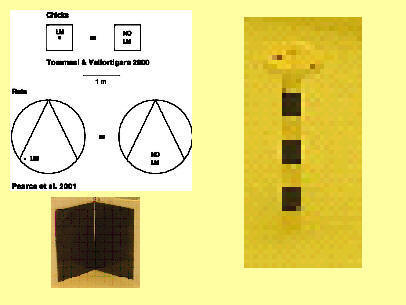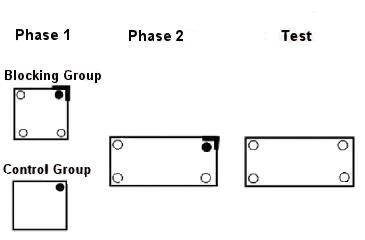Geometry, features, and orientation in vertebrate
animals: A pictorial review
Ken Cheng and Nora S. Newcombe
Macquarie University & Temple University
Cue Competition
In cue competition, the experience of one cue affects the learning of a second cue adversely. In overshadowing, the presence of an additional cue affects learning adversely; thus, A is learned better alone than in AB compound. In blocking, a previously learned cue affects learning adversely. Thus, if B is learned in Phase 1, and AB is presented in Phase 2, A may not be learned well. B is said to block the learning of A.
Cue competition is found in the case of learning to use landmark objects to localize a target. Landmarks overshadow one another, and a previously learned landmark can block the learning of a new landmark (review: Chamizo, 2003).
However, the picture is entirely different when it comes to learning to using geometric information.
In chicks (Tommasi & Vallortigara, 2000), pigeons (Kelly et al., 1998) and rats (Hayward et al., 2003; Pearce et al., 2001; Wall et al., 2004), a beacon (landmark right at the target) does not block or overshadow the learning of geometric information.
|
|
Figure
G-1:
Top-left - The situations used by Tommasi and Vallortigara (2000) and Pearce et al. (2001). Bottom-left and Right - Beacons used for rats (color photos thanks to Anthony McGregor). |
Tommasi and Vallortigara (2000, Figure I-1 top left panel, top part) trained chicks to search in the middle of a square. They either had a prominent beacon at the center or not. The beacon was a potential cue competitor with geometric cues. When tested with the geometric cues alone (without the beacon), however, both groups performed similarly, giving no evidence of the overshadowing of geometric cues by a beacon.
Pearce et al. (2001) and Hayward et al. (2003) trained rats to find a corner of a swimming pool, where a hidden platform was located for escaping the water. An example is shown in the top left panel, bottom part. They found that having a prominent beacon right at the target corner neither overshadowed nor blocked the learning of geometric cues. The rats in these situations with cue competition still managed to find the target without the beacon present, as well as animals that learned geometric cues without a beacon. A beacon failed to be a cue competitor of geometric cues.
|
|
| Figure G-2: An experiment from Wall et al. (2004) |
Rats in the blocking group learned to use a beacon to find food in one of four corners in Phase 1. Control rats had only the food dish, without the beacon, in Phase 1. In Phase 2, geometric cues were introduced in the form of a rectangular arena. Geometric cues were not as good a predictor as the beacon, because it left a two-fold ambiguity. Nevertheless, both groups showed equal evidence of using geometric cues, because they made rotational errors to similar extents. In the test with geometric cues alone, both groups proved to use geometric cues equally well.
Thus, a prominent beacon did not block the learning of geometry. Wall et al. concluded that beacons and geometry are learned independently.
|

